|
|
 |
 |
 |
 |
 |
 |
 |
| |
|
 |
Nepal
|
 |
|
| |
 |
|
 |
|
| Introduction
|
|
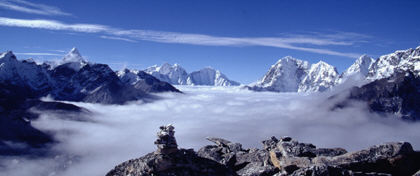
Draped along the greatest heights of the Himalaya, the kingdom
of Nepal is a land of sublime scenery, time-worn temples,
and some of the best walking trails on earth. It's a poor
country, but it's rich in scenic splendour and cultural treasures.
The kingdom has long exerted a pull on the Western imagination
and it's a difficult place to dislodge from your memory once
you return. This is why so many travellers are drawn back
to Nepal, armed the second time round with a greater appreciation
of its natural and cultural complexity, a stout pair of walking
boots and a desire for improved leg-definition.
An international
airport at Kathmandu makes Nepal one of the most accessible
Himalayan countries. Kathmandu is a bustling city of medieval
grandeur, with temples, bazaars and hooting motorists creating
its unique atmosphere. The Kathmandu valley alone contains
seven World Heritage Sites!
Today
Nepal entertains about 300,000 visitors each year, providing
them with not only adventure and thrills of nature, but cultural
experiences that encompass two thousand years of human development.
|
| Facts
at a Glance |
| Name |
Kingdom
of Nepal |
| Area |
147,181
sq km |
| Population |
23
million |
| Capital |
Kathmandu
(pop 700,000) |
| People |
Various
ethnic groups, including the Bhotiya (which include the
Sherpa), Khas, Kirati, Magar, Newari, Tharu, Tamong and
Tibetans |
| Language |
Nepali
(also called Gurkhali), similar to Hindi |
| Religion |
90%
Hindu, 5% Buddhist, 3% Muslim |
| Government |
Democracy |
| Prime
Minister |
Krishna
Prasad Bhattari |
|
| Geography
|
|
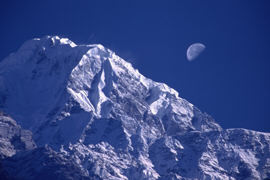 Nestled
between Tibet and India, Nepal stretches from north-west to
south-east about 800 km and varies in width from around 90
km to 230 km. Bounded by the world's highest mountains to
the north and Indian plains to the south, Nepal has one of
the world's most dynamic climactic systems - from lowland
jungles to desert-like Tibetan plateau and from temperate
highland forests to ice-bound alpine peaks. Nestled
between Tibet and India, Nepal stretches from north-west to
south-east about 800 km and varies in width from around 90
km to 230 km. Bounded by the world's highest mountains to
the north and Indian plains to the south, Nepal has one of
the world's most dynamic climactic systems - from lowland
jungles to desert-like Tibetan plateau and from temperate
highland forests to ice-bound alpine peaks.
Nepal
is undoubtedly the best known and most visited of the Himalayan
kingdoms. Situated in the central region of the greater Himalayas,
Nepal contains 8 of the world's 14 highest peaks and more
highest mountains than any other country.
Many of
the highest peaks, including Mt. Everest, lie along Nepal's
northern border with Tibet. Other mountains, such as the Annapurna
Massif, lie entirely within Nepal.
|
| History
|
|
Nepal's
colorful history dates back thousands of years as a major
crossroads between the many kingdoms that make up the present-day
China and India.
In 1372,
one of the Malla rulers, Jayasthiti Malla, successfully
conquered Patan and Bhaktapur, thereby unifying Kathmandu
Valley. The Malla dynasty was at its peak under the reign
of Yaksha Malla (1428-1482), who cultivated the arts and encouraged
the construction of temples. Much of these magnificent
architectures can still be seen in Patan and Bhaktapur. When
the king died in 1482, however, the kingdom again splits into
warring states.
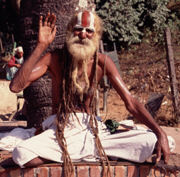
In 1768,
King Prithvi Narayan Shah from the kingdom of Gorkha, halfway
between Kathmandu and Pokhara, conquered the valley and moved
his capital to Kathmandu. However, in 1846 Jung Bahadur
Rana engineered a palace revolt and declared himself the prime
minister. He then made the title hereditary. As a result,
although the Shah dynasty continues to this
day, real power in the palace had been in the hands of the
Ranas until 1950.
During
the 1940s the Nepal Congress Party, which represented the
interests of the commoners and led by B. P. Koirala, had begun
to form. In the late 1940 King Tribhuvan (Shah) escaped from
his palace to India Embassy, and from there to India. After
an extended mediation by the Indian government, which restored
power to the king, the king returned to Nepal in 1951 and
set up a government comprised of Ranas and members of the
Nepal Congress Party.
King Tribhuvan
died in 1955 and was succeeded by his son Mahendra. In the
ensuing years the Congress Party gained considerable popularity.
When the first general election was held in 1959, the Congress
Party won overwhelming support and Koirala became the prime
minister. Two years later, however, King Mahendra seized total
political power by arresting the cabinet and banning all opposition
parties.
King Mahendra
died in 1972 and was succeeded by his western-educated son
Birendra, but political oppression continued. Until late 1980,
leaders of opposition parties spent times in and out of jail
or in self-imposed exile, while the country was embroiled
in public protests and riots.
In February
1990 the government crushed non-violent democracy movement
with bullets, tear gas, mass arrests and torture. After few
months of turmoil and pressure from various foreign aid donors
the government was forced to backed down. On April 9, the
ban on opposition political parties was lifted and a new constitution
was created. In the spring of 1991 a new parliament led by
opposition coalition was elected by the people.
|
| People,
Religion and Culture |
|
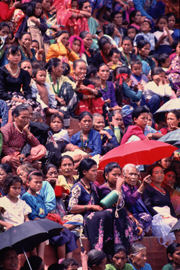 Culturally
and linguistically, Nepal's diverse population can be divided
into two groups of Indian and Mongolian origins. Nepalese
in the southern Terai regions are closely related to people
of northern India, while Nepalese in the foothills of the
high Himalayas bordering Tibet are essentially Mongolian. Culturally
and linguistically, Nepal's diverse population can be divided
into two groups of Indian and Mongolian origins. Nepalese
in the southern Terai regions are closely related to people
of northern India, while Nepalese in the foothills of the
high Himalayas bordering Tibet are essentially Mongolian.
Among
Nepal's numerous ethnic groups, the best known are the Sherpa
(mountaineering guides), Gurung (Gorkha soldiers),
Newar (master craftsmen) and the Thakali (traders
and entrepreneur).
Ethnic
tribes and their religious beliefs do not follow any set pattern.
Generally, people in the lowlands practice Hinduism, while
those in the high Himalayas follow Hindu-Tantric Buddhism
practices. In the mountainous regions there are numerous cultures
based on these two religious systems, often coexisting with
dual worship or with other indigenous religions.
Contrary
to popular belief, the birthplace of lord Buddha is not in
India but in the town of Lumbini in Nepal. This fact makes
Nepal the Mecca for the world's entire Buddhist worshipers.
|
| National
Parks, Wildlife Reserves & Conservation Areas
|
|
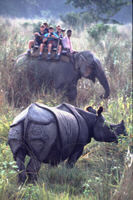 Nepal
is a land of extreme contrast in climate and geography. Within
a mere 150 kilometers the land rises from near sea level in
the south to over 8000 meters in the north. This, together
with the monsoon rainfall along the south-facing slopes, has
resulted in compacting virtually all climate zones found on
planet Earth. As a result, Nepal has been endowed with a great
diversity of life-zones providing a home for a large variety
of plants, birds and animals. Nepal
is a land of extreme contrast in climate and geography. Within
a mere 150 kilometers the land rises from near sea level in
the south to over 8000 meters in the north. This, together
with the monsoon rainfall along the south-facing slopes, has
resulted in compacting virtually all climate zones found on
planet Earth. As a result, Nepal has been endowed with a great
diversity of life-zones providing a home for a large variety
of plants, birds and animals.
Currently
there are 8 national parks, 3 wildlife reserves and 2 conservation
areas encompassing over 13,000 sq. km of pristine and biologically
diverse land. Among these are the great Sagarmatha (Everest)
and Annapurna National Parks containing Nepal's most famous
treks, the Everest Base Camp and Annapurna Circuit routes!
Chief among the wildlife parks is the Royal Chitwan National
Park pictured above most famous for its easily spotted wild
rhinos and shyer tigers.
|
| Climate |
|
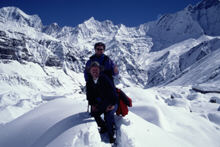 As
in Sikkim and Bhutan, the brief but heavy monsoon nourishes
an abundanceof exotic vegetation. The valleys and foothills
are cloaked with bamboo and a multitude of other plants, flowers,
and trees. As
in Sikkim and Bhutan, the brief but heavy monsoon nourishes
an abundanceof exotic vegetation. The valleys and foothills
are cloaked with bamboo and a multitude of other plants, flowers,
and trees.
Within
the boundaries of Nepal, the incredible effect of the Himalayas
on terrain, climate, vegetation and culture is best exemplified.
|
| Links |
|
For more
information on Nepal, how to get there and what you'll find
when you do why not check out the following resources:
|
|
|
 |
|
|



